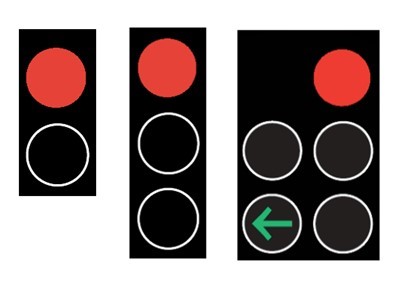Traffic controls at intersections
A summary of the key road rules for traffic signals and signs at intersections.
There are different signs and signals that you must obey at intersections. These are explained below.
Penalties
The penalties for failing to obey signs and signals at intersections include fines and demerit points.
The rules in detail
The key road rules and reference numbers regarding signs and signals at intersections are:
- 56 - Stopping for a red traffic light or arrow
- 57 - Stopping for a yellow traffic light or arrow
- 58 - Exceptions to stopping for a red or yellow traffic light
- 59 - Proceeding through a red traffic light
- 60 - Proceeding through a red traffic arrow
- 60A - Proceeding through a bicycle storage area before a red traffic light or arrow
- 61 - Proceeding when traffic lights or arrows at an intersection change to yellow or red
- 62 - Giving way when turning at an intersection with traffic lights
- 63 - Giving way at an intersection with traffic lights not operating or only partly operating
- 64 - Giving way at a flashing yellow traffic arrow at an intersection
- 65 - Giving way at a marked foot crossing (except at an intersection) with a flashing yellow traffic light
- Part 17 – Additional rules for drivers of trams and public buses and in the case of B lights, to other vehicles permitted to drive in a bus lane
If you are facing a traffic light that is:
- red, you must stop and don't go into the intersection
- yellow, you must stop unless you can't stop safely
- green, you can go through the intersection if there is room for your vehicle on the other side. You are not allowed to block the intersection.
Traffic lights can be in various configurations from a single configuration to multiple configurations to allow for through and turning lanes. Always pay attention to the traffic lights and if you see a red light in the direction you are heading you must stop at the stop line.

Traffic lights with arrows
Show more
If you want to make a turn at an intersection that has traffic lights with arrows you:
- must stop if the arrow pointing in the direction you are wanting turn is red
- can make your turn if the arrow pointing in the direction you want to go is green and it is safe.
Traffic light failure or flashing yellow
Show more
If the traffic lights at an intersection are not working, or their lights are flashing yellow, you must follow the same give way rules as you would at an intersection that has a stop or give way sign or line.
Traffic lights for trams, buses and bicycles
Show more
At some intersections there are traffic lights that show a white T or B on a black background. When these lights are on, trams and buses can go through the intersection. All other drivers must wait for the normal green lights or turning arrows.
Some traffic lights show pictures of red, yellow and green bicycles. These lights are for bicycle riders only. All other road users must obey the normal traffic lights and signals.
At many intersections there are red and green pedestrian lights which tell pedestrians when they are allowed to cross.
When turning at an intersection you must always give way to pedestrians who are entering or crossing the road you are turning into. This rule applies whether the pedestrian lights are green or not.
Stop and give way signs
Show more
Stop and give way signs are used at many intersections. Give way rules apply when you see these signs.
The video below shows you some of the rules for giving way at intersections.
Giving way at intersections